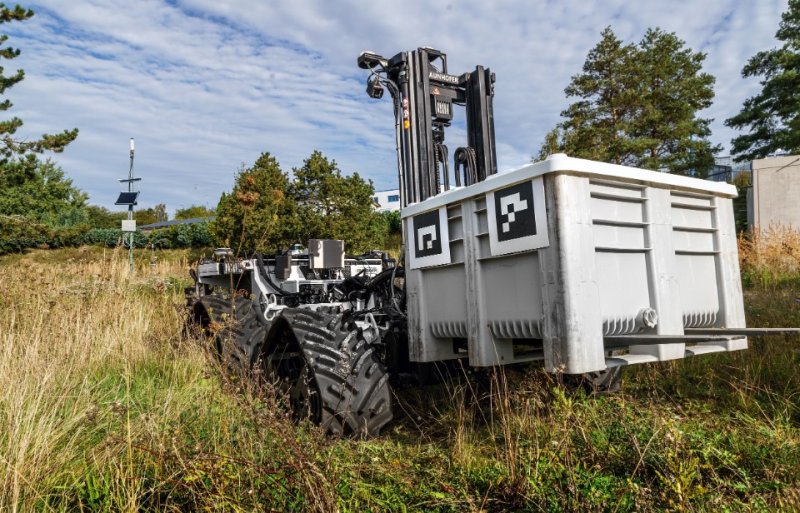· Press Release
Scientists from Fraunhofer IOSB-AST successfully control forklift with 5G and Internet over a distance of 260 kilometers using teleoperation
As part of a demonstration, scientists from Fraunhofer IOSB-AST were able to successfully teleoperate the autonomous mobile transport system "MATS", a modified PALFINGER forklift, over a distance of 260 kilometers (Ilmenau – Karlsruhe). A local 5G network was used along with special automation technologies to process and evaluate the numerous sensor data. Future fields of application include the remote control of mobile machinery in a wide variety of scenarios.
The "MATS" forklift has already been used in a technology demonstration as part of the AKIT-PRO research project (https://a-kit.de/) in Celle/Scheuen in summer 2023. The focus here was on the interaction between various autonomous work machines for the recovery of hazardous goods. The successful teleoperation now carried out between Ilmenau and Karlsruhe as part of the ROBDEKON project (https://robdekon.de/) focused on the fact that automation-supported manipulation of palletized goods is not only possible and technically feasible over a few hundred meters, but also over much greater distances.

A special feature of the "MATS" forklift is the generalizable interface developed by scientists at Fraunhofer IOSB-AST: this enables remote control via different control stations. At the same time, the flexibility of the system is increased. During the successful test at the ROBDEKON participation event, for example, the "shared autonomy" control station from the German Research Center for Artificial Intelligence GmbH (DFKI) in Bremen was used.
Thanks to the lidar and image data available locally on the vehicle, fully autonomous load transportation is already feasible. However, load loading and unloading stations often have to be specially set up for such scenarios, which reduces the flexibility of using such forklifts. However, in order to reduce the burden on factory transportation, the autonomy functionalities can be used in conjunction with teleoperability at dedicated locations. Locally installed 5G cells help to reduce the latency for sensor image data transmission and thus keep the vehicle operable.
Robot models and the truck's existing 3D environment data are used to create a kind of digital twin, which the teleoperator uses to generate virtual camera positions from which he can assess the situation from different angles and ultimately take action. Similar to lane departure warning systems in cars, autonomous functions help the operator to avoid collisions with objects in the truck's field of vision.
"We are already working with partners from industry on projects to manipulate loads in factories using teleoperation. The findings from the AKIT-PRO project are a great help to us in implementing industry-hardened solutions," says Prof. Andreas Wenzel, Head of the Embedded Intelligent Systems department at Fraunhofer IOSB-AST.
If you have any questions about teleoperation of mobile machines, please contact Christoph Eisenhut, christoph.eisenhut@iosb-ast.fraunhofer.de, Tel. +49367746118